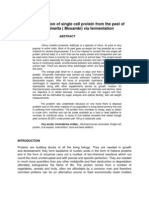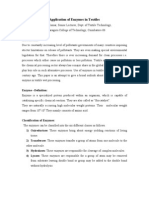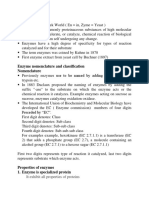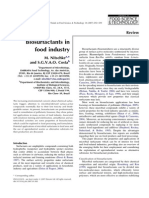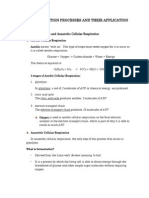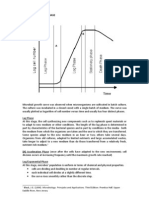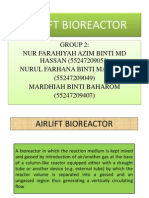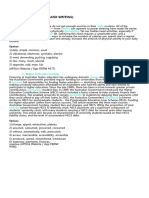Microbial Enzymes PDF
Microbial Enzymes PDF
Uploaded by
nsiahadamsCopyright:
Available Formats
Microbial Enzymes PDF
Microbial Enzymes PDF
Uploaded by
nsiahadamsOriginal Title
Copyright
Available Formats
Share this document
Did you find this document useful?
Is this content inappropriate?
Copyright:
Available Formats
Microbial Enzymes PDF
Microbial Enzymes PDF
Uploaded by
nsiahadamsCopyright:
Available Formats
Microbiological Process Report
Production of Microbial Enzymes and Their Applications
L. A. UNDERKOFLER, R. R. BARTON,
AND
S. S. RENNERT
Takamine Laboratory, Division of Miles Laboratories, Inc., Clifton, New Jersey
Received for publication October 1, 1957
Enzymes are biocatalysts produced by living cells to
bring about specific biochemical reactions generally
forming parts of the metabolic processes of the cells.
Enzymes are highly specific in their action on substrates and often many different enzymes are required
to bring about, by concerted action, the sequence of
metabolic reactions performed by the living cell. All
enzymes which have been purified are protein in nature,
and may or may not possess a nonprotein prosthetic
group.
The practical application and industrial use of enzymes to accomplish certain reactions apart from the
cell dates back many centuries and was practiced long
before the nature or function of enzymes was understood. Use of barley malt for starch conversion in
brewing, and of dung for bating of hides in leather
making, are examples of ancient use of enzymes. It was
not until nearly the turn of this century that the
causative agents or enzymes responsible for bringing
about such biochemical reactions became known. Then
crude preparations from certain animal tissues such as
pancreas and stomach mucosa, or from plant tissues
such as malt and papaya fruit, were prepared which
found technical applications in the textile, leather,
brewing, and other industries. Once the favorable
results of employing such enzyme preparations were
established, a search began for better, less expensive,
and more readily available sources of such enzymes.
It was found that certain microorganisms produce
enzymes similar in action to the amylases of malt and
pancreas, or to the proteases of the pancreas and papaya
fruit. This led to the development of processes for
producing such microbial enzymes on a commercial
scale.
Dr. Jokichi Takamine (1894, 1914) was the first
person to realize the technical possibility of cultivated
enzymes and to introduce them to industry. He was
mainly concerned with fungal enzymes, whereas Boidin
and Effront (1917) in France pioneered in the production of bacterial enzymes about 20 years later.
Technological progress in this field during the last
decades has been so great that, for many uses, micro-
bial cultivated enzymes have replaced the animal or
plant enzymes. For example, in textile desizing, bacterial amylase has largely replaced malt or pancreatin.
At present, only a relatively small number of microbial
enzymes have found commercial application, but the
number is increasing, and the field will undoubtedly be
much expanded in the future.
PRODUCTION OF MICROBIAL ENZYMES
Enzymes occur in every living cell, hence in all
microorganisms. Each single strain of organism produces a large number of enzymes, hydrolyzing, oxidizing or reducing, and metabolic in nature. But the
absolute and relative amounts of the various individual
enzymes produced vary markedly between species
and even between strains of the same species. Hence,
it is customary to select strains for the commercial
production of specific enzymes which have the capacity
for producing highest amounts of the particular enzymes desired. Commercial enzymes are produced
from strains of molds, bacteria, and yeasts as shown
in table 1.
Up until less than 10 years ago, commercial fungal
and bacterial enzymes were produced by surface
culture methods. Within the past few years, however,
submerged culture methods have come into extensive
use. Descriptions of processing methods for preparing
industrial microbial enzymes have been published
(Underkofier, 1954; Hoogerheide, 1954; Forbath, 1957).
TABLE 1
Some commercial enzymes and source microorganisms
Source
Fungal
Bacterial
Yeast
Presented at Symposium, Society for Industrial Microbiology, Storrs, Connecticut, August, 1956.
'
212
Enzyme
Amylases
Glucosidases
Proteases J
Pectinases
Glucose oxidasel
J
Catalase
Amylases
Proteases
PenicillinaseJ
Invertase
Lactase
Microorganism
Aspergillus oryzae
Aspergillus flavus
(Aspergillus niger
Aspergillus niger
fPenicillium notatum
XAspergillus niger
Bacillus subtilis
Saccharomyces cerevisiae
Saccharomyces fragilis
1958]
15IICROBIAL ENZYMIES
For fungal enzymes, modifications of Dr. Takamine's
original mold bran process have usually been employed.
In this process, the mold is cultivated on the surface
of a solid substrate. Takamine used wheat bran and
this has come to be recognized as the most satisfactory
basic substrate although other fibrous materials can be
employed. Other ingredients may be added, such as
nutrient salts, acid or buffer to regulate the pH, soy
bean meal or beet cosettes to stimulate enzyme production. In one modification of the bran process, the
bran is steamed for sterilization, cooled, inoculated
with the mold spores, and spread out on trays (Underkofler et al., 1947; Forbath, 1957). Incubation takes
place in chambers where the temperature and humidity
are controlled within limits by circulated air. It may
be stated that instead of trays for incubation, Takamine, as well as other producers, at one time used
slowly rotating drums. Generally tray incubation gives
more rapid growth and enzyme production.
Bacterial enzymes have been and are also produced
by the bran process. However, until recently the process originally invented by Boidin and Effront (1917)
was most extensively employed (Wallerstein, 1939).
In this process, the bacteria are cultivated in special
culture vessels as a pellicle on the surface of thin layers
of liquid medium, the composition of which is adjusted
for maximum production of the desired enzyme. Different strains of Bacillus subtilis and different media are
employed, depending on whether bacterial amylase or
protease is desired.
The submerged method was originally developed
and first extensively employed for production of penicillin and other antibiotics. So much has been written
recently about submerged culture of molds and bacteria
that it is unnecessary to go into detail here. In the
laboratory, submerged cultures are grown in shake
flasks or in aerated tubes or flasks. Commercially, deep
tanks are employed which have provision for introduction of sterile air and for vigorous agitation. The
amount of air, degree of dispersion of air, and amount of
agitation are dependent variables. For effective results
the air must be dispersed in very fine bubbles throughout the mass of culture liquid. Fine aeration through
porous substances may be used to produce high dispersion. Most manufacturers, however, depend upon
efficient agitators to break up the air into the requisite
small bubbles.
Either surface or submerged culture methods currently may be employed for most microbial enzymes
production. Usually different cultures must be used for
maximum enzyme yields by the two methods, although
there are exceptions to this rule. There are advantages
and disadvantages to each method, some of which are
shown in table 2. Which method is used for a particular commercial enzyme will be dictated by plant
213
equipment, convenience, relative yields, and application.
Recovery of the enzyme generally depends upon
precipitation from an aqueous solution, although some
enzymes may be marketed as stabilized solutions. In
the bran process, the enzyme is extracted from the
koj i (the name given to the mass of material permeated with the mold mycelium) into an aqueous
solution by percolation. In the liquid processes, the
microbial cells are filtered from the beer. The enzyme
may be precipitated by addition of solvents, such as
acetone or aliphatic alcohols, to the aqueous enzyme
solution, either directly or after concentration by
vacuum evaporation at low temperature. The precipitated enzyme may be filtered and dried at low
temperature, for example in a vacuum shelf dryer.
The dry enzyme powders may be sold as undiluted
concentrates on a potency basis or, for most applications, may be diluted to an established standard
potency with an acceptable diluent. Some common
diluents are salt, sugar, starch, and wheat flour. Most
commercial enzymes are quite stable in the dry form,
but some require the presence of stabilizers and activators for maximum stability and efficiency in use.
In theory, the fermentative production of microbial
enzymes is a simple matter, requiring an appropriate
organism grown on a medium of optimum composition
under optimum conditions. The stocks in trade of
microbial enzyme manufacturers are thus the selected
cultures, the composition of media, and the cultural
conditions, all of which are usually held confidential.
In practice, enzyme manufacturers suffer the same
difficulties in fermentation, frequently in even greater
degree, as antibiotics producers. Total loss of fermentation batches may result from contamination, culture
variation, failure of cultural control, and other like
causes. Furthermore, knowledge and careful application of the best methods for recovery, stabilization, and
TABLE 2
Conmparison of sutrface and submerged processes
Submerged
Surface
Requires much space for Uses compact closed fermentrays
Requires much hand labor
Uses low pressure air blower
Little power requirement
Minimum control necessary
Little contamination problem
Recovery involves extraction
with aqueous solution, filtration or centrifugation,
and perhaps evaporation
and/or precipitation
tors
Requires minimum of labor
Requiires high pressure air
Needs considerable power for
air compressors and agi-
tatoIrs
Requires careful control
Contamination frequently
serious problem
Recovery involves filtration
or centrifugation, and per-
haps evaporation and/or
precipitation
L. A. UNDERKOFLER, R. R. BARTON, AND S. S. RENNERT
214
storage of such delicate biological entities as the labile
enzymes presents a constant challenge.
APPLICATIONS OF MICROBIAL ENZYMES
Uses of microbial enzymes in food, pharmaceutical,
textile, paper, leather, and other industries are numerous and are increasing rapidly. The more important
current uses are listed in table 3. Most of the industrially
important microbial enzymes, with two major exceptions at present, are hydrolases, which catalyze
the hydrolysis of natural organic compounds.
Carbohydrases
Carbohydrases are enzymes which hydrolyze polysaccharides or oligosaccharides. Several carbohydrases
have industrial importance, but the amylases have the
greatest commercial application.
The various starch-splitting enzymes are known as
amylases, the actions of which (Kerr, 1950; Myrback
and Neumiller, 1950; Meyer and Gibbons, 1951;
Bernfeld, 1951) may be expressed in greatly simplified
form as follows:
Starch
a-amylase
(liquefying amylase)
Starch
(saccharifying amylase)
f3-amylase
Dextrins
Starch
or
dextrins + maltose
maltose
dextrinase
dextrins
maltose
amyloglucosidase
glucose
The terms "liquefying" and "saccharifying" amylases
general classifications denoting the principal types
of amylase action. f-Amylase, which is not of microbial
origin, is a true saccharifying enzyme, forming maltose
directly from starch by cleaving disaccharide units
from the open ends of chains. The a-amylases from
different sources usually have good liquefying ability,
but may vary widely in saccharifying ability and thermal stability. Amyloglucosidase is a saccharifying
enzyme unique in that it attacks starch and 1,4-linked
glucose oligosaccharides with direct formation of
glucose. A range of amylases, suitable for almost any
kind or extent of starch conversion, is now available
from microbial sources.
Bacterial amylase preparations generally remain
operative at considerably higher temperature than do
fungal amylases, and at elevated temperatures give
rapid liquefaction of starch. A significant application
of the bacterial enzyme is in the continuous process for
desizing of textile fabrics (Gale, 1941; Wood, 1947).
Another is in preparing modified starch sizing for
textiles (Gale, 1941) and starch coatings for paper
(Gale, 1941; Schwalbe and Gillan, 1957).
High temperature stability is also important in the
are
[VOL. 6
brewing industry where microbial amylases have found
use in supplementing low diastatic malt, and especially
for initial liquefaction of adjuncts such as rice and corn
grits (Schellhas, 1956). Additional specific uses for
bacterial amylase is in preparing cold water dispersible
laundry starches (Pigman et al., 1952) and in removing
wall paper.
Fungal amylases possess relatively low thermal
stability but act rapidly at lower temperatures and
produce good saccharification. An enormous potential
use for fungal amylase is as a saccharifying agent for
grain alcohol fermentation mashes. At least two
alcohol plants in this country regularly use fungal
amylase for this purpose. It has been repeatedly shown
that use of fungal amylases results in better alcohol
yields than with malt conversion (Underkofler et al.,
1946; U. S. Department of Agriculture, 1950).
An extremely important use for fungal amylases is
in conversion of partially acid hydrolyzed starch to
sweet syrups. Acid hydrolysis is a random action
whereas enzymic hydrolysis is a patterned one. By
proper control of the type and proportion of enzymes
used (a-amylase, amyloglucosidase, maltase) syrups of
almost any desired proportions of glucose, maltose, and
dextrins may be produced (Dale and Langlois, 1940;
Langlois, 1953). Crystalline glucose will probably soon
be manufactured by amyloglucosidase conversion of
starch, in competition with the conventional acid
hydrolysis process.
Amylases find extensive use in baking. Use of fungal
amylase by the baker to supplement the diastatic
activity of flour is common practice. The fungal
amylase has the advantage of low inactivation temperature. This permits use of high levels of the amylase to
improve sugar production, which increases gas formation and improves crust color, without danger of
excessive dextrinization of the starch during baking
(Johnson and Miller, 1948, 1949; Harrel et al., 1950;
Reed, 1952a; Miller et al., 1953; Pence, 1953).
The first industrial manufacture of fungal enzyme,
Takadiastase, in this country was for a pharmaceutical
digestive aid, and this continues to be a major appli-
cation (Beazell, 1942).
Other applications of microbial amylases where
both fungal and bacterial enzymes are utilized are in
processing cereal products for food dextrin and sugar
mixtures and for breakfast foods, for preparation of
chocolate and licorice syrups to keep them from congealing, and for recovering sugars from scrap candy of
high starch content. Fungal amylases are also used for
starch removal for flavoring extracts and for fruit
extracts and juices, and in preparing clear, starch-free
pectin. Microbial amylases are used for modifying
starch in vegetable purees, and in treating vegetables
for canning (Bode, 1954).
Several disaccharide-splitting carbohydrases have
1958]
MICROBIAL ENZYMES
215
TABLE 3
Uses of industrial enzyme preparations
Industry
Application
Enzyme
Source *
Extent
of
Uset
Baking and milling
Bread baking
Amylase
Protease
Amylase
Protease
Fungal, malt
Fungal
Beer
Mashing
Malt, bacterial
Chillproofing
Papain, bromelain, pepsin, fungal,
bacterial
Oxygen removal
Glucose oxidase
Fungal
Carbonated beverages Oxygen removal
Glucose oxidase
Fungal
Cereals
Precooked baby foods
Amylase
Malt, fungal
Breakfast foods
Amylase
Malt, fungal
Condiments
Protease
Papain, bromelain, pepsin, fungal,
bacterial
Chocolate, cocoa
Syrups
Amylase
Fungal, bacterial
Coffee
Coffee bean fermentation
Pectinase
Fungal
Coffee concentrates
Pectinase, hemicellu- Fungal
lase
Confectionery, candy Soft center candies and fondants
Invertase
Yeast
Sugar recovery from scrap candy
Bacterial, fungal
Amylase
Dairy
Cheese production
Rennin
Animal
Milk, sterilization with peroxide
Catalase
Liver, bacterial
Milk, prevention of oxidation flavor Protease
Pancreatin
Milk, protein hydrolyzates
Protease
Papain, bromelain, pancreatin,
fungal, bacterial
Evaporated milk, stabilization
Protease
Pancreatin, pepsin, bromelain,
fungal
Whole milk concentrates
Yeast
Lactase
Ice cream and frozen desserts
Yeast
Lactase
Yeast
Lactase
Whey concentrates
Dried milk, oxygen removal
Glucose oxidase
Fungal
Amylase
Malt, fungal, bacterial
Mashing
Distilled beverages
Protease, lipase, am- Bacterial, pancreatin, fungal
Dry cleaning, laundry Spot removal
ylase
Fungal
Glucose oxidase
Glucose removal
Eggs, dried
Fungal
Mayonnaise, oxygen removal
Glucose oxidase
Pepsin, pancreatin, bromelain,
Pig starter rations
Protease, amylase
Feeds, animal
fungal
Fungal
Amylase
Removal of starch, clarification
Flavors
Fungal
Glucose oxidase
Oxygen removal
Fungal
Fruits and fruit juices Clarification, filtration, concentra- Pectinases
tion
Fungal, vegetable
Pectinesterase
Low methoxyl pectin
Fungal
Amylase
Starch removal from pectin
Fungal
Glucose oxidase
Oxygen removal
Bacterial, pancreatin, fungal
Protease
Bating
Leather
Bacterial, fungal, pancreatin
Protease, mucolytic
Unhairing
Papain, bromelain, fungal
Protease
Meat tenderizing
Meat, fish
Papain, bromelain, fungal
Protease
Tenderizing casings
Papain, bromelain, bacterial
Protease
Condensed fish solubles
Bacterial, malt
Starch modification for paper coat- Amylase
Paper
ing
Fungal
Amylase, dextrinase
Corn syrup
Starch and syrup
Amylase, amylogluco- Fungal
Production of glucose
sidase
Bacterial
Amylase
Cold swelling laundry starch
Fungal, pancreatin
Amylase
Pharmaceutical and Digestive aids
Papain, pancreatin, Ibromelain,
Protease
clinical
2
1
1
1
3
3
2
2
2
2
2
2
2
3
1
3
2
2
4
3
3
2
3
1
1
1
4
3
3
3
1
2
2
4
1
4
2
3
2
2
1
3
2
1
1
pepsin, fungal
Wound debridement
Lipase
Cellulase
Streptokinase-streptodornase, trypsin,
bromelain
Pancreatin
Fungal
Bacterial, animal, plant
3
3
1
L. A. UNDERKOFLER, R. R. BARTON, AND S. S. RENNERT
216
[VOL. 6
TABLE 3-Continued
Industry
Photographic
Textile
Vegetables
Wine
Miscellaneous
Application
Enzyme
Extent
of
Source*
Injection for bruises, inflammation, Streptokinase, trypsin
etc.
Paper test strips for diabetic glu- Glucose oxidase, percose
oxidase
Varied clinical tests
Numerous
Recovery of silver from spent film Protease
Desizing of fabrics
Amylase
Protease
Liquefying purees and soups
Amylase
Dehydrated vegetables, restoring Flavor
flavor
Pressing, clarification, filtration
Pectinases
High test molasses
Invertase
Resolution racemic mixtures of Protease
amino acids
Wall paper removal
Amylase
Uiset
Bacterial, animal
Fungal, plant
Plant, animal, microorganisms
Bacterial
Bacterial, malt, pancreatin
Bacterial, fungal, pancreatin
Fungal
Plants
3
1
1
1
3
4
Fungal
Yeast
Fungal
2
1
4
Bacterial
* Where one of optional sources predominates it has been italicized.
t 1 General and extensive industrial use.
2 Industrial use by some manufacturers.
3 Limited industrial use.
4 Laboratory or experimental use only.
considerable importance. For the purpose of demonstrating analogous action, the three enzymes, maltase,
lactase, and invertase may be considered together:
Maltose
Lactose
Sucrose
maltase
lactase
a>
glucose + glucose
glucose + galactose
invertase
> glucose + fructose
These enzymes all attack their corresponding disaccharides with the formation of two molecules of monosaccharide. All may be obtained from fungal and
bacterial sources, but invertase and lactase are obtained commercially from yeasts. Yeast and fungal
invertases both hydrolyze sucrose, but differ in the
nature of their actions. Yeast invertase is a fructosidase,
attacking the fructose end, whereas fungal invertase is a
glucosidase, attacking the glucose end of the sucrose
molecule. This may be demonstrated by comparing
activities against certain tri- and tetra-saccharides.
For example, yeast invertase splits raffinose into fructose and melibiose, but there is no reaction with fungal
invertase since glucose is not terminal in the raffinose
molecule:
yeast invertase
Raffinose
(fructose glucose
-galactose)
fructose +
melibiose
(glucose * galactose)
Invertase (Neuberg and Roberts, 1946; Neuberg
and Mandl, 1951) is employed in manufacturing
artificial honey, and particularly for invert sugar which
is much more soluble than sucrose. Hence, a very large
use of crude invertase is to prevent crystallization in
high test molasses. The high solubility of invert sugar is
also important in the manufacture of confectioneries,
liqueurs, and ice cream where high sucrose concentrations would lead to crystallization. Invertase is also
used in the preparation of chocolate coated, soft cream
center candies. Molding and coating are carried out
while the contents are firm, after which invertase
action yields a smooth, stable cream.
Lactase (Reed, 1952b) may be employed in preventing lactose crystallization in ice cream, which
causes "grainy" or "sandy" ice cream. Lactase also
prevents lactose crystallization in both whole milk
and whey concentrates.
Maltase, while not marketed as such, plays an
important role, as mentioned above, in the preparation
of sweet syrups by the enzymic degradation of starch.
Proteases
Industrially available proteolytic enzymes produced
by microorganisms are usually mixtures of endopeptidases (proteinases) and exopeptidases. In overly
simplified form the action of the proteases may be
formulated:
Raffinose
fungal invertase
nno reaction
Proteins
endopeptidases
proteoses
peptones
polypeptides
exopeptidases
amino
acids
1958]
MICROBIAL ENZYMES
In addition to microbial proteases, the plant proteases
bromelin, papain, and ficin, and the animal proteases,
pepsin and trypsin, have extensive industrial application. Because of the complex structures and high
molecular weights of proteins made up of some 20
different amino acids, enzymic proteolysis is extremely
complicated. Most proteases are quite specific with
regard to which peptide linkages they can split (Smith,
1951). Hence, it is necessary to select the appropriate
protease complex or combination of enzymes for specific
applications. Usually this can only be determined by
trial and error methods. By means of such experimentation, however, many and diverse uses have been
found for the various proteases. With proper selection
of enzymes, with appropriate conditions of time,
temperature, and pH, either limited proteolysis or
complete hydrolysis of most proteins to amino acids
can be brought about.
Microbial proteolytic enzymes from different fungi
and bacteria are available. Most fungal proteases will
tolerate and act effectively over a wide pH range
(about 4 to 8), while with a few exceptions, bacterial
proteases generally work best over a narrow range of
about pH 7 to 8.
Fungal protease has been used for centuries in the
Orient for the production of soy sauce, tamari sauce,
and miso, a breakfast food (Hoogerheide, 1954). In
these usages, soybeans or other grains are steamed and
inoculated with spores of Aspergillus flavus-oryzae or
Aspergillus tamarii. After maximum enzyme production
has taken place, the koji is covered with brine and
enzymatic digestion allowed to take place. Limited use
is made of this process for making soy sauce in this
country also. In these uses, no attempt is made to
separate the enzymes from the producing organisms.
For most industrial applications, the microbial proteases
are extracted from the growth medium as described in
an earlier section of this paper.
One of the largest uses for fungal protease is in
baking bread and crackers (Johnson and Miller, 1949;
Pence, 1953; Miller and Johnson, 1955). The proper
amount of protease action reduces mixing time and
increases extensibility of doughs, and improves grain,
texture, and loaf volume. However, excess of protease
must be avoided, and the time for enzyme action and
quantity of enzyme used must be carefully controlled
by the baker or sticky, unmanageable doughs will
result.
Cereal foods are also treated with proteolytic enzymes to modify their proteins, resulting in better
processing, including improved product handling,
increased drying capacity, and lower power requirements.
To prevent development of undesirable haze in beer
and ale when these beverages are cooled, proteolytic
enzymes are added during the finishing operation to
"chillproof" these beverages. Chillproofing agents
217
contain pepsin, papain, bromelin, fungal and bacterial
proteases in various combinations, and digest enough
of the protein to prevent formation of haze (Wallerstein, 1956).
Proteolytic enzymes are used for tenderizing meats,
and animal casings for processed mieats. Consumer
products contain papain and bromelin as active agents.
Recent work at the American Meat Institute (Wang
and Maynard, 1955) has shown that various proteolytic
enzymes preferentially attack different meat tissues.
Recent practical tests have indicated that combinations
of plant, fungal, and bacterial proteases have an advantage over any single enzyme for meat tenderizing.
Protein hydrolyzates for condiments and special
diets, and for animal feeds, are obtained by extensive
enzymatic hydrolysis of plant, meat and fish, and milk
proteins. Enzymatic processing has the advantage
over acid or alkaline hydrolysis of proteins in the simple
equipment employed and the lack of destruction or
racemization of amino acids.
Pharmaceutical and clinical applications for fungal
proteases include their use in digestive aids, and for
bacterial proteases (streptokinase-streptodornase) in
debridement of wounds and by injection to relieve
inflammation, bruises, and blood clots.
Bacterial enzymes are used throughout the dry
cleaning industry (Ferracone, 1951). Dry cleaning
solvents will not remove proteinaceous stains, such as
milk, egg, and blood, from clothing. Digesters containing bacterial proteases are used to solubilize such
stains during the dry cleaning operation without damaging the fabric. A somewhat similar application is the
use of bacterial proteases for desizing and degumming
textiles.
Other major industrial applications of bacterial
proteases include bating and unhairing of hides for
leather manufacture (Wallerstein Co., 1929), and for
recovering silver from photographic film by enzyme
digestion and solubilization of the gelatin coating.
Pectinases
The pectolytic enzymes are another important group
of enzymes of microbial origin (Kertesz, 1951; Lineweaver and Jansen, 1951). The two well recognized
types of pectolytic enzymes are pectinesterase and
polygalacturonase, the actions of which in overly
simplified form are:
Pectin pectinesterase
methanol +
polygalacturonic acid
Polygalacturonic acid
polygalacturonase
galacturonic acid
Most commercial pectin enzymes are mixtures of these
and probably other enzymes. An excellent review of
the rather complex nature of pectolytic enzymes has
218
L. A. UNDERKOFLER, R. R. BARTON, AND S. S. RENNERT
recently been published by Demain and Phaff (1957).
Pectins are colloidal in nature, making solutions
viscous and holding other materials in suspension.
Pectinesterase removes methyl groups from the pectin
molecules exposing carboxyl groups which in the presence of bi- or multivalent cations, such as calcium, form
insoluble salts which can readily be removed. At the
same time, polygalacturonase degrades macromolecular
pectin, causing reduction in viscosity and destroying
the protective colloidal action so that suspended materials will settle out.
Extensive use of pectolytic enzymes is made in
processing fruit juices. Addition of pectic enzymes to
grapes or other fruits during crushing or grinding
results in increased yields of juice on pressing. Wine
from grapes so treated will usually clear faster when
fermentation is complete, and have better color.
Most consumers prefer clear fruit juices. The cloud,
such as in fresh cider, is usually material held in suspension by pectin and filtration is difficult, if not impossible. The safest way to accomplish pectin removal
without affecting color or flavor is to treat the juice
with a pectic enzyme. Juice for jelly manufacture is
frequently depectinized since more uniform jelly can
be achieved when a standard amount of pectin is added
in controlled amounts. The variable quality and quantity of the natural pectin in the juice does not then
interfere.
Pectic enzymes are necessary for making high density
fruit juice concentrates or purees. If apple juice is
concentrated to 720 Brix without removal of the naturally occurring pectin, a gel will result rather than the
desired liquid concentrate. In most cases, juices are
depectinized and filtered before concentration, but in
others the pectinase is allowed to act while the juice
is being concentrated.
Another use for pectic enzymes is in removing the
gelatinous coating from coffee beans (Johnston and
Kirby, 1950). Natural fermentation produced by
microorganisms on the beans formerly was used for this
purpose but sometimes gives unpredictable results.
Other Hydrolytic Enzymes
Other useful hydrolytic enzymes include cellulase,
hemicellulase, and pentosanase. Partly due to lack of
commercial availability of high-potency products,
particularly for cellulase, they are not yet of major
industrial importance.
There are numerous potential uses for cellulase, such
as in tenderizing cellulosic food products and recovering cellulosic wastes. Manufacturers are actively
seeking more active cellulases, and large-scale uses
must awa$t their availability.
Hemicellulases are active in hydrolyzing certain
gums. One industrial application is in preventing
gelation in coffee concentrates, where pectic enzymes
[VOL. 6
are not effective (Reich et al., 1957). Other uses are in
partially degrading various natural gums to reduce the
viscosity of solutions of these gums.
Simpson (1955) has reported increased yields of high
quality starch from wheat by use of pentosanase.
Lipases are produced by numerous organisms but
have little industrial application, despite the importance
of fats in foods.
Nonhydrolytic Enzymes
Only two nonhydrolytic enzymes at present have
large-scale industrial applications, glucose oxidase
and catalase (Snyder, 1953).
Glucose oxidase is of fungal origin, and acts in the
presence of oxygen to convert glucose to gluconic acid
and hydrogen peroxide. It is highly specific and oxidizes
only $-D-glucose.
oxidase
C6H1206 + 02 + H20 glucose
(glucose)
(C6H1207 + H202
(gluconic acid)
Catalase, which is also present in commercial fungal
glucose oxidase preparations, acts on hydrogen peroxide
to yield water and oxygen.
catalase
2H20 + 02
The net reaction of the glucose oxidase-catalase enzyme system therefore results in one-half mole of oxygen being consumed for each mole of glucose oxidized
2C6H1207
2C6H1206 + 02 glucose oxidase-catalase
2H202
The glucose oxidase-catalase system is used commercially both for removing glucose and for removing
oxygen. An interesting application is also its use as a
test reagent since it is specific for glucose. This suggestion was first made by Keilin and Hartree (1948),
and it has had considerable use in laboratories for this
purpose as a quantitative measure of glucose in the
presence of other sugars (Whistler et al., 1953; Froesch
and Renold, 1956). Commercial application is in the
form of paper test strips for diabetic patients, which
indicate the presence of glucose in the urine by a color
change when the strip is dipped into the sample (Hunt
et al., 1956; Adams et al., 1957). Numerous other uses
for these test strips for qualitative detection of glucose
are also possible.
Extensive industrial use is made of glucose oxidase
in desugaring eggs before they are dried (Baldwin et al.,
1953). Such removal of glucose greatly enhances shelf
life of dried egg products by preventing the occurrence
of "browning" and other deteriorative processes.
The problem in marketing of certain canned foods
and drinks is oxygen rather than glucose. In the case of
19581
MICROBIAL ENZYMES
liquid products, glucose oxidase and a little glucose are
simply dissolved in them before packing. Residual
oxygen in the cans is thus removed by action of the
glucose oxidase. For example, in canned soft drinks,
the three major changes which may occur are loss of
color, alteration of flavor, and can corrosion. Different
flavors vary in their susceptibilities to these changes
which may be traced to "head space" oxygen remaining
in the can. Addition of small amounts of glucose oxidase
to canned soft drinks has been shown (Barton et al.,
1955) to greatly enhance the keeping quality and
diminish can corrosion of susceptible canned beverages.
With cheese, glucose oxidase and glucose are coated
on the inside of the wrapper where it contacts the
cheese (Sarett and Scott, 1956).
Following the same principles of application, many
other uses for glucose oxidase become possible in
packaged foodstuffs where the presence of glucose or of
oxygen in the food or container presents a deterioration
hazard.
A recently patented (Scott, 1956) deoxygenation
packet holds tremendous potential for future application. These packets are made of a film, such as
polyethylene, which is impermeable to water, but
allows the diffusion of oxygen. They contain glucose
oxidase-catalase, along with glucose and appropriate
buffers. When placed in sealed containers the packets
rapidly take up the residual oxygen, leaving an atmosphere free of oxygen. The Quartermaster Food and
Container Institute (Kurtz and Yonezawa, 1957)
have reported special effectiveness of the packets in
protecting dried and dehydrated products containing
fats and other oxygen-sensitive materials. These enzyme packets may prove to be a practical solution in
packaging dried foods and other items which now have
short shelf life due to fat rancidity or other oxidative
changes.
Catalase, essentially free of other enzymes, may
readily be obtained from bacteria (Herbert and Pinsent,
1948), and also from animal sources. Cold-sterilization
of milk for cheese processing, now under consideration,
will provide an industrial outlet for catalase. Hydrogen
peroxide is added to the milk to sterilize it, and catalase
is used to remove the residual hydrogen peroxide
before further processing the milk into cheese.
FUTURE OF INDUSTRIAL ENZYMES
Industrial uses of enzymes have increased greatly
during the past few years. Prospects are excellent for
continuing increased usage of presently available
enzymes in present applications, and in new uses, and
of new enzymes for many purposes.
Enzymes have several distinct advantages for use in
industrial processes:
1. They are of natural origin and are nontoxic.
219
2. They have great specificity of action; hence can
bring about reactions not otherwise easily carried out.
3. They work best under mild conditions of moderate
temperature and near neutral pH, thus not requiring
drastic conditions of high temperature, high pressure,
high acidity, and the like, which necessitate special
expensive equipment.
4. They act rapidly at relatively low concentrations,
and the rate of reaction can be readily controlled by
adjusting temperature, pH, and amount of enzyme
employed.
5. They are easily inactivated when reaction has
gone as far as desired.
Because of these inherent advantages, many industries are keenly interested in adapting enzymatic
methods to the requirements of their processes. Examples of some applications under intensive investigation include unhairing of hides for leather, protection
of foods and other materials against oxidation, resolution of racemic mixtures of amino acids, and restoration of flavor to dehydrated or canned foods.
Another recent application of enzymes has been in
clinical test reagents. Additional developments in this
field can be expected.
Clinical application of enzymes has been developing
also. Proteolytic enzymes are used for debridement of
wounds, and promising clinical results have been reported by injection of certain enzymes such as streptokinase, crystalline trypsin, and chymotrypsin. Since
many physical ailments result from derangement of
metabolic enzyme systems, increased therapeutic use
of enzymes, presently unpredictable, may be expected.
For clinical and therapeutic uses, highly purified and
perhaps crystalline enzymes will be necessary. Availability of high purity enzymes on an industrial scale
is just beginning, and rapid advances in this field
may be expected.
Currently much enzyme research is underway by
various industries including enzyme manufacturers.
Such research is devoted to finding new and improved
methods for using enzymes, to improving yields of
industrial microbial enzymes, and to finding new enzymes for industrial purposes. Continually increasing
usage of old and new enzymes will result from such
research.
SUMMARY
The processes for industrial production of microbial
enzymes by surface and submerged procedures have
been reviewed.
A table listing current industrial uses of enzymes
has been presented and the major uses of the microbial
carbohydrases (amylases, invertase, lactase and maltase), the proteases, the pectinases, glucose oxidase
and catalase have been described.
220
L. A. UNDERKOFLER, R. R. BARTON, AND S. S. RENNERT
REFERENCES
ADAMS, E. C., BURKHART, C. E., AND FREE, A. H. 1957
Specificity of a glucose oxidase test for urine glucose.
Science, 125, 1082-1083.
BALDWIN, R. R., CAMPBELL, H. A., THIESSEN, R., AND LORANT,
G. J. 1953 The use of glucose oxidase in processing of
foods with special emphasis on desugaring egg white.
Food Technol., 7, 275-282.
BARTON, R. R., RENNERT, S. S., AND UNDERKOFLER, L. A.
1955 Enzyme protects canned drinks. Food Eng., 27,
79-80, 198-199.
BEAZELL, J. M. 1942 The effect of supplemental amylase on
digestion. J. Lab. Clin. Med., 27, 308-319.
BERNFELD, P. 1951 Enzymes of starch degradation and synthesis. Advances in Enzymol., 12, 379-428.
BODE, H. E. 1954 Enzyme acts as tenderizer. Food Eng.,
26, 94.
BOIDIN, A. AND EFFRONT, J. 1917 Bacterial enzymes. U.
S. Pat. 1,227,374 and 1,227,525.
DALE, J. K. AND LANGLOIS, D. P. 1940 Starch conversion
syrup. U. S. Pat. 2,201,609.
DEMAIN, A. L. AND PHAFF, H. J. 1957 Recent advances in
the enzymatic hydrolysis of pectic substances. Wallerstein Labs. Communs., 20, 119-140.
FERRACONE, W. J. 1951 Enzymes-Their function and use
in spotting. Neighborhood Drycleaner, 5, 13-14.
FORBATH, T. P. 1957 Flexible processing keys enzymes'
future. Chem. Eng., 64, 226-229.
FROESCH, E. R. AND RENOLD, A. E. 1956 Specific enzymatic
determination of glucose in blood and urine using glucose
oxidase. Diabetes, 5, 1-6.
GALE, R. A. 1941 Enzymes in industry. I. Their use in textile, paper and related fields. Wallerstein Labs. Conmuns., 4, 112-120.
HARREL, C. G., LINCOLN, H. W., AND GUNDERSON, F. L. 1950
Purified enzymes from Aspergillus oryzae in bread production. Baker's Dig., 24, 97-100.
HERBERT, D. AND PINSENT, J. 1948 Crystalline bacterial
catalase. Biochem. J., 43, 193-202.
HOOGERHEIDE. J. C. 1954 Microbial enzymes other than
fungal amylases. In Industrial fermentations, Vol. II, pp.
122-154. Edited by L. A. Underkofler and R. J. Hickey.
Chemical Publishing Co., New York, New York.
HUNT, J. A., GRAY, C. H., AND THOROGOOD, D. E. 1956 Enzyme tests for the detection of glucose. Brit. Med. J.,
4, 586-588.
JOHNSON, J. A., AND MILLER, B. S. 1948 High levels of alphaamylase in baking. I. Evaluation of the effect of alphaamylase from various sources. Cereal Chem., 25, 168-190.
JOHNSON, J. A. AND MILLER, B. S. 1949 Studies on the role
of alpha-amylase and proteinase in bread-making. Cereal
Chem., 26, 371-383.
JOHNSTON, W. R. AND KIRBY, G. W. 1950 Preparation of
green coffee. U. S. Pat. 2,526,873.
KEILIN, D. AND HARTREE, E. F. 1948 The use of glucose
oxidase (notatin) for the determination of glucose in biological material and for the study of glucose producing
systems by manometric methods. Biochem. J., 42, 230238.
KERR, R. W. 1950 Chemistry and industry of starch, 2nd ed.
Academic Press, Inc., New York, New York.
KERTESZ, Z. I. 1951 Pectic enzymes. In The enzymes, Vol.
I, Part 2, pp. 745-768. Edited by J. B. Sumner and K.
Myrback. Academic Press, Inc., New York, New York.
KURTZ, G. W. AND YONEZAWA, Y. 1957 The glucose oxidasecatalase system as an oxygen scavenger for hermetically
sealed containers. 17th Meeting, Institute of Food Technologists, Abstract No. 19. Food Technol., 11, 16.
[VOL. 6
LANGLOIS, D. P. 1953 Application of enzymes to corn syrup
production. Food Technol., 7, 303-307.
LINEWEAVER, H. AND JANSEN, F. 1951 Pectic enzymes.
Advances in Enzymol. 11, 267-296.
MEYER, K. H. AND GIBBONS, G. C. 1951 The present status
of starch chemistry. Advances in Enzymol., 12, 341-378.
MILLER, B. S. AND JOHNSON, J. A. 1955 Fungal enzymes in
baking. Baker's Dig., 29, 95-100, 166-167.
MILLER, B. S., JOHNSON, J. A., AND PALMER, D. L. 1953 A
comparison of cereal, fungal and bacterial alpha-amylases
as supplements for breadbaking. Food Technol., 7, 38-42.
MYRBXCK, K., AND NEUMtLLER, G. 1950 Amylases and the
hydrolysis of starch and glycogen. In The enzymes, Edited by J. B. Sumner and K. Myrback, Vol. I, Part 1, pp.
653-724. Academic Press, Inc., New York, New York.
NEUBERG, C. AND MANDL, I. 1951 Invertase. In The enzymes,
Vol. I, Part 1, pp. 527-550. Edited by J. B. Sumner and K.
Myrback. Academic Press, Inc., New York, New York.
NEUBERG, C. AND ROBERTS, I. S. 1946 Invertase monograph.
Sugar Research Foundation, New York, New York.
PENCE, J. W. 1953 Panary fermentation. Current status of
problems. J. Agr. Food Chem., 1, 157-161.
PIGMAN, W. W., KERR, R. W., AND SCHINK, N. F. 1952 Cold
water dispersible starch product and method of preparing
the same. U. S. Pat. 2,609,326.
REED, G. 1952a Fungal enzymes in bread baking. Food
Technol., 6, 339-341.
REED, G. 1952b Commercial enzyme permits raising the
ratio of skim milk. Food Eng., 24, 108.
REICH, I. M., REDFERN, S., LENNEY, J. F., AND SCHIMMEL, W.
W. 1957 Prevention of gel in frozen coffee extract. U.
S. Pat. 2,801,920.
SARETT, B. L. AND SCOTT, D. 1956 Enzyme-treated sheet
product and article wrapped therewith. U. S. Pat.
2,765,233.
SCHELLHAS, G. 1956 A brief review of enzymes. Modern
Brewery Age, 55, 61-66.
SCHWALBE, H. C. AND GILLAN, E. P. 1957 Enzyme conversions of starch. TAPPI Monograph No. 17, pp. 39-53.
Technical Association of the Pulp and Paper Industry,
New York, New York.
SCOTT, D. 1956 Deoxygenating process and product. U.
S. Pat. 2,758,932.
SIMPSON, F. J. 1955 The application of bacterial pentosanases to the recovery of starch from wheat flours.
Can. J. Technol., 33, 33-40.
SMITH, E. L. 1951 Proteolytic enzymes. In The enzymes,
Vol. 1, Part 2, pp. 793-872. Edited by J. B. Sumner and K.
Myrback. Academic Press, Inc., New York, New York.
SNYDER, E. G. 1953 New enzymes open new doors. Food
Eng., 25, 89-90, 92.
TAKAMINE, J. 1894 Process of making diastatic enzyme. U.
S. Pat. 525,820 and 525,823.
TAKAMINE, J. 1914 Enzymes of Aspergillus oryzae and the
application of its amyloclastic enzyme to the fermentation industry. Ind. Eng. Chem., 6, 824-828.
UNDERKOFLER, L. A. 1954 Fungal amylolytic enzymes. In
Industrial fermentations, Vol. II, pp. 97-121. Edited by
L. A. Underkofler and R. J. Hickey. Chemical Publishing
Co., New York, New York.
UNDERKOFLER, L. A., SEVERSON, G. M., AND GOERING, K. J.
1946 Saccharification of grain mashes for alcoholic fermentation. Plant-scale use of mold amylase. Ind. Eng.
Chem., 38, 980-985.
UNDERKOFLER, L. A., SEVERSON, G. M., GOERING, K. J., AND
CHRISTENSEN, L. M. 1947 Commercial production and
use of mold bran. Cereal Chem., 24, 1-22.
U. S. Department of Agriculture 1950 Methods and costs of
ANTIBIOTIC EFFECT IN SOIL
producing alcohol from grain by the fungal amylase process on a commercial scale. Tech. Bull. No. 1024.
WALLERSTEIN, L. 1939 Enzyme preparations from microorganisms. Commercial production and industrial application. Ind. Eng. Chem., 31, 1218-1224.
WALLERSTEIN, L. 1956 Chillproofing and stabilization of
beer. Wallerstein Labs. Communs., 19, 95-107.
Wallerstein Co. 1929 Bating and unhairing hides. British
Pat. 355,306.
221
WANG, H. AND MAYNARD, N. 1955 Studies on enzymatic
tenderization of meat. I. Basic technique and histological
observations of enzymatic action. Food Research, 20,
587-597.
WHISTLER, R. L., HOUGH, L., AND HYLIN, J. W. 1953 Determination of D-glucose in corn sirups. Anal. Chem.,
25, 1215-1216.
WOOD, P. G. 1947 Enzymes in textile processing. Am.
Dyestuff Reptr., 36, 79-84.
Microbiological Process Report
The Persistence and Biological Effects of Antibiotics in Soil"2
D. PRAMER
Department of Agricultural Microbiology, New Jersey Agricultural Experiment Station, Rutgers, The State University,
New Brunswick, New Jersey
Received for publication October 28, 1957
The use of antibiotics in sprays and dusts applied to
agricultural crops for the control of plant diseases has
given rise to questions of immediate and practical
importance. This review summarizes information on the
fate of antibiotics that reach the soil, their persistence
and susceptibility to chemical and microbiological
degradation, and their effects on microbiological processes related to soil fertility and crop production. The
influence of antibiotics on seed germination and plant
growth is discussed briefly. The ecological significance
of antibiotic production under natural conditions is
not considered since it was the subject of recent reviews
by Brian (1949, 1957).
THE PERSISTENCE OF ANTIBIOTICS IN SOIL
The inactivation of antibiotics in soil may be the
result of one or more of three distinct processes: (a)
intrinsic chemical instability of the antibiotic molecule;
(b) adsorption on soil clay minerals and organic
matter; and (c) microbiological degradation.
The inactivation of such antibiotics as penicillin,
viridin, gliotoxin, frequentin, and albidin may be
partially or wholly explained by their intrinsic chemical
instability in aqueous solution at the pH of the soil
tested (Jefferys, 1952; Wright, 1954). The rapid inPaper of the Journal Series, New Jersey Agricultural Experiment Station, Rutgers, The State University of New
Jersey, Department of Agricultural Microbiology, New Brunswick. This investigation was supported in part by Research
Grant E1919 from the National Institute of Allergy and Infectious Disease, National Institutes of Health, Public Health
Service.
2 Presented as part of a symposium on pesticides in soils
at the Golden Anniversary Meeting of the American Society
of Agronomy, Atlanta, Georgia, 1957.
'
activation of cycloheximide, gladiolic acid, and penicillin in sterilized soil under pH conditions favorable to
stability (Gottlieb et al., 1952; Jefferys, 1952)- suggests
that these antibiotics are subject to undefined chemical
transformations. It is possible that in such cases the
antibiotic is hydrolyzed or oxidized chemically with
some soil constituent acting as catalyst.
The adsorption of antibiotics by soil was noted by
various investigators (Waksman and Woodruff, 1942;
Pramer and Starkey, 1950a; Winter and Willeke,
1951; Gregory et al., 1952; Hessayon, 1953) and studied
extensively (Siminoff and Gottlieb, 1951; Gottlieb
et al., 1952; Gottlieb and Siminoff, 1952; Martin and
Gottlieb, 1952; Martin and Gottlieb, 1955). Basic
antibiotics are adsorbed by clay minerals and soil
organic matter, whereas neutral and acidic antibiotics
are not adsorbed to any significant extent. Amphoteric
antibiotics will act as either an acid or base depending
on their isoelectric point and the pH of the soil. Since
the pH of the soil is usually lower than the isoelectric
point of the antibiotic, these substances behave as
basic compounds in most cases.
The adsorption of antibiotics by clay minerals results
in expansion of the crystal lattice and flocculation of
the clay. Although the biological activity of adsorbed
antibiotics may be reduced (Skinner, 1956), it should
not be concluded that the adsorption is irreversible and
the inactivation permanent. Siminoff and Gottlieb
(1951) showed that adsorbed streptomycin entered into
base-exchange reactions and was to a limited extent
replaceable by the dyes, methylene blue and janus
green. Likewise, Ark and Alcorn (1956) reported that
the addition of dipotassium phosphate, peptone, or
certain other substances to a bentonite-streptomycin
You might also like
- Wastewater Microbiology, Filamentous Bacteria Morphotype Identification Techniques, and Process Control Troubleshooting StrategiesFrom EverandWastewater Microbiology, Filamentous Bacteria Morphotype Identification Techniques, and Process Control Troubleshooting StrategiesNo ratings yet
- Microorganisms On SludgeDocument10 pagesMicroorganisms On Sludgegra00No ratings yet
- Fermentation Technology Chapter I II III IVDocument42 pagesFermentation Technology Chapter I II III IVPuvenez TamalantanNo ratings yet
- Blessed in The DarknessDocument190 pagesBlessed in The DarknessAnaeli GayosoNo ratings yet
- Automatic Side Stand SystemDocument25 pagesAutomatic Side Stand SystemAravindh Kumar50% (4)
- Microbial EnzymesDocument50 pagesMicrobial EnzymesJohnry Maloles100% (1)
- Single Cell Protein Production A Review PDFDocument12 pagesSingle Cell Protein Production A Review PDFseharNo ratings yet
- Production of Single Cell Protein From Pineapple Waste and Orange Peel Using Yeasts and AspergillusnigerDocument46 pagesProduction of Single Cell Protein From Pineapple Waste and Orange Peel Using Yeasts and AspergillusnigerReader100% (2)
- Investigation Anaerobic Processes Septic Tank Wastewater TreatmentDocument5 pagesInvestigation Anaerobic Processes Septic Tank Wastewater TreatmentSaj Bhai100% (1)
- Single Cell ProteinsDocument20 pagesSingle Cell ProteinsStephen MooreNo ratings yet
- Single Cell Protein (SCP) Production by Bacillus Subtilis From Pineapple Fruit ExtractDocument42 pagesSingle Cell Protein (SCP) Production by Bacillus Subtilis From Pineapple Fruit ExtractBoppani Ram ManoharNo ratings yet
- Production of Single Cell Protein From Orange PeelDocument5 pagesProduction of Single Cell Protein From Orange PeelHarish Kasam100% (1)
- Rumen Enzyme PDFDocument200 pagesRumen Enzyme PDFAdnan AhmedNo ratings yet
- Dairy Effluent Treatment Systems TechnoteDocument11 pagesDairy Effluent Treatment Systems TechnoteMohmmad IbrahimNo ratings yet
- Application of Enzymes in TextilesDocument7 pagesApplication of Enzymes in TextilesSENTHIL KUMARNo ratings yet
- Coagulants and Natural Polymers: Perspectives For The Treatment of WaterDocument8 pagesCoagulants and Natural Polymers: Perspectives For The Treatment of Waterhuonggiangnguyen3011No ratings yet
- Enzymes Mechanism of Enzyme ActionDocument8 pagesEnzymes Mechanism of Enzyme Actionkl42c4300No ratings yet
- Ion-Exchange and Adsorbent Resins For Food IndustryDocument28 pagesIon-Exchange and Adsorbent Resins For Food IndustryMario Darío Gatto0% (1)
- CM1205 Chromogenic Coliform Agar ISODocument2 pagesCM1205 Chromogenic Coliform Agar ISOMaria AspriNo ratings yet
- Unit 2Document87 pagesUnit 2SavitaNo ratings yet
- Aerobic Anaerobic Fermentation1Document16 pagesAerobic Anaerobic Fermentation1Ken AguilaNo ratings yet
- Bioprocessing EngineeringDocument9 pagesBioprocessing EngineeringKuo SarongNo ratings yet
- Bio FoulingDocument26 pagesBio FoulingBenedict Paul100% (1)
- Biogas ProductionDocument7 pagesBiogas ProductionFagbohungbe MichaelNo ratings yet
- Downstream ProcessDocument37 pagesDownstream ProcessSwetha Bhattu100% (2)
- Monitoring, Operation and Control of Ion Exchange Plant: Mel HallDocument73 pagesMonitoring, Operation and Control of Ion Exchange Plant: Mel HallefasaravananNo ratings yet
- Extraction of Cellulose From Some IndustrialDocument121 pagesExtraction of Cellulose From Some IndustrialSathvik PrinceNo ratings yet
- Physico-Chemical Characterization of A Biosurfactant Produced byDocument23 pagesPhysico-Chemical Characterization of A Biosurfactant Produced byKV DeepikaNo ratings yet
- Green ChemistryDocument35 pagesGreen Chemistryalia nasirNo ratings yet
- Sitrik Asit 44 - 141Document9 pagesSitrik Asit 44 - 141Oğuzhan OsmanlıoğluNo ratings yet
- Biosurfactants in Food IndustryDocument8 pagesBiosurfactants in Food Industry2begeniusNo ratings yet
- Biochemistry (New Version)Document45 pagesBiochemistry (New Version)Hoa Vo0% (1)
- Fermentation Processes and Their Application PDFDocument8 pagesFermentation Processes and Their Application PDFninasabelita100% (9)
- Performance Evaluation of Effluent Treatment Plant of Dairy Industry PDFDocument6 pagesPerformance Evaluation of Effluent Treatment Plant of Dairy Industry PDFMortezaNo ratings yet
- Microbial Growth PhaseDocument2 pagesMicrobial Growth PhaseMahathir Mohmed100% (5)
- Starch Hydrolysis by AmylaseDocument9 pagesStarch Hydrolysis by Amylasegaurav saxenaNo ratings yet
- Bioresource Technology: Raveendran Sindhu, Parameswaran Binod, Ashok PandeyDocument7 pagesBioresource Technology: Raveendran Sindhu, Parameswaran Binod, Ashok PandeyMuhammad Fakhrizal Fahmi100% (1)
- Dextrose EquivalentDocument5 pagesDextrose EquivalentMirra NovyantiNo ratings yet
- The Safe Use of Cationic Flocculants With Reverse Osmosis MembranesDocument8 pagesThe Safe Use of Cationic Flocculants With Reverse Osmosis Membranesak47ichiNo ratings yet
- Development of Dynamic Compartment Models For Industrial Aerobic Fed-Batch Fermentation ProcessesDocument14 pagesDevelopment of Dynamic Compartment Models For Industrial Aerobic Fed-Batch Fermentation ProcessesLuis ReyesNo ratings yet
- Alvim Biofilm Monitoring SystemDocument11 pagesAlvim Biofilm Monitoring SystemAndy WirjawanNo ratings yet
- EnzymesDocument6 pagesEnzymesADEEL AHMADNo ratings yet
- FermenterDocument19 pagesFermenterIshtiaque HossainNo ratings yet
- Anaerobic Processes: Rate Systems. Thus One Can Have A Low-Rate, Suspended-Growth Anaerobic System WhichDocument6 pagesAnaerobic Processes: Rate Systems. Thus One Can Have A Low-Rate, Suspended-Growth Anaerobic System Whichnickao123No ratings yet
- 978 90 481 3509 7Document505 pages978 90 481 3509 7Shruti NaikNo ratings yet
- Role of Ethylene in Fruit RipeningDocument23 pagesRole of Ethylene in Fruit RipeningpoojaNo ratings yet
- Mechanism of Absorption of WaterDocument6 pagesMechanism of Absorption of WaterketakeeNo ratings yet
- Bioactives From Fruit Processing WastesDocument13 pagesBioactives From Fruit Processing WastesNormix FlowersNo ratings yet
- Determin of Aero Anaerobic Spore FormersDocument6 pagesDetermin of Aero Anaerobic Spore FormersbhaleshNo ratings yet
- Foulants and Cleaning Procedures of RO MembraneDocument7 pagesFoulants and Cleaning Procedures of RO MembranesushantNo ratings yet
- Caustic Recovery Using Membrane FiltrationDocument9 pagesCaustic Recovery Using Membrane FiltrationQuân Nguyễn ĐứcNo ratings yet
- Eco EnzymeDocument4 pagesEco EnzymeJenson Lew0% (1)
- Polymer Adhesives Note - DR Akinsiku PDFDocument15 pagesPolymer Adhesives Note - DR Akinsiku PDFGlory UsoroNo ratings yet
- Industrial Production of Enzyme Protease PDFDocument25 pagesIndustrial Production of Enzyme Protease PDFAyushman Kumar BanerjeeNo ratings yet
- 1-Basics of MicrobiologyDocument53 pages1-Basics of MicrobiologyKiran Shrestha100% (1)
- The Role of Microorganisms-LibreDocument4 pagesThe Role of Microorganisms-Librenirajlamichhane100% (1)
- A To Z of Enzyme TechnologyDocument303 pagesA To Z of Enzyme TechnologyJake PoppeNo ratings yet
- Bentonite Wastewater Treatment PDFDocument12 pagesBentonite Wastewater Treatment PDFBiljana TausanovicNo ratings yet
- 1 Bakers Yeast: Saccharomyces Cerevisiae Is Known As Top-Fermenting Yeast. It Is One of The Major Types ofDocument8 pages1 Bakers Yeast: Saccharomyces Cerevisiae Is Known As Top-Fermenting Yeast. It Is One of The Major Types ofhammoudeh1No ratings yet
- Airlift BioreactorDocument18 pagesAirlift BioreactorDark_Kiro100% (1)
- Advantages of Solid State Fermentation Over Submerged FermentationDocument32 pagesAdvantages of Solid State Fermentation Over Submerged Fermentationtelangsachin12No ratings yet
- Electrochemical Remediation Technologies for Polluted Soils, Sediments and GroundwaterFrom EverandElectrochemical Remediation Technologies for Polluted Soils, Sediments and GroundwaterNo ratings yet
- SG3KTL-D Certificado IEEE1547-2003 UL1741Document2 pagesSG3KTL-D Certificado IEEE1547-2003 UL1741Jose GraciaNo ratings yet
- Natasha Nicolle Alderite 5272196 0 1Document6 pagesNatasha Nicolle Alderite 5272196 0 1Badass LadyNo ratings yet
- 2.2 Research Paper - Machinery Mechanization - Crop Establishment MachineryDocument24 pages2.2 Research Paper - Machinery Mechanization - Crop Establishment MachineryArman RiveraNo ratings yet
- Notification For Backlog Recruitment UCEK JNTUK101017 1Document10 pagesNotification For Backlog Recruitment UCEK JNTUK101017 1Muqthiar Ali0% (2)
- Opt551 Fiber Reinforced PlasticsDocument1 pageOpt551 Fiber Reinforced Plasticshaston kumar0% (1)
- Block WorkDocument11 pagesBlock WorkSharad SinghNo ratings yet
- CW3 Mind ControlDocument2 pagesCW3 Mind ControlRigel ZabateNo ratings yet
- Care and Serve - Sep 2012Document16 pagesCare and Serve - Sep 2012doorkeepersNo ratings yet
- Applied Economics Module 1Document30 pagesApplied Economics Module 1愛結No ratings yet
- 1 s2.0 S2214785322056073 MainDocument7 pages1 s2.0 S2214785322056073 MainManikandan HariharanNo ratings yet
- Practical Research Module 4 Lesson 3Document6 pagesPractical Research Module 4 Lesson 3Shiela RodrigoNo ratings yet
- Robust Estimation Methods and Outlier Detection in Mediation ModelDocument25 pagesRobust Estimation Methods and Outlier Detection in Mediation ModelJoanne WongNo ratings yet
- Emily Byrne - Resume TemplateDocument2 pagesEmily Byrne - Resume Templateapi-581369232No ratings yet
- UntitledDocument68 pagesUntitledapi-233604231No ratings yet
- Fib (RW) - March - KeyDocument9 pagesFib (RW) - March - KeyNga PhamNo ratings yet
- Artificial Intelligence Unit 1: IntroductionDocument11 pagesArtificial Intelligence Unit 1: IntroductionTCOD71 Aditya DeshmukhNo ratings yet
- Lecture 5 (Signal-Flow-Graphs) PDFDocument5 pagesLecture 5 (Signal-Flow-Graphs) PDFMomenNaeemNo ratings yet
- UntitledDocument93 pagesUntitledyoyohoney singleNo ratings yet
- Unit 1 (WB)Document12 pagesUnit 1 (WB)Lê Thảo VyNo ratings yet
- Astronomy QuestionDocument3 pagesAstronomy Questionapi-374038512No ratings yet
- Introduction To Language TestingDocument29 pagesIntroduction To Language TestingTasya RamadaniNo ratings yet
- Sow Form 4Document141 pagesSow Form 4DamiafazirahNo ratings yet
- Tooth Discoloration: DR Bindu Kumari (BDS)Document32 pagesTooth Discoloration: DR Bindu Kumari (BDS)محمد العراقيNo ratings yet
- UP Graduate Studies Reference ReportDocument1 pageUP Graduate Studies Reference ReportmikollimNo ratings yet
- Blockbuster Video: Written Analysis of Cases Assignment-6Document8 pagesBlockbuster Video: Written Analysis of Cases Assignment-6Sid DharthNo ratings yet
- Ducati Superbike: Owner's ManualDocument122 pagesDucati Superbike: Owner's ManualCA GDNo ratings yet
- Reading 6 Hypothesis TestingDocument32 pagesReading 6 Hypothesis TestingARPIT ARYANo ratings yet
- Comp 6204 Voip:: Taridium Ipbx Express Free Edition 5 Users (Asterisk Based)Document17 pagesComp 6204 Voip:: Taridium Ipbx Express Free Edition 5 Users (Asterisk Based)nathan fitnessNo ratings yet











